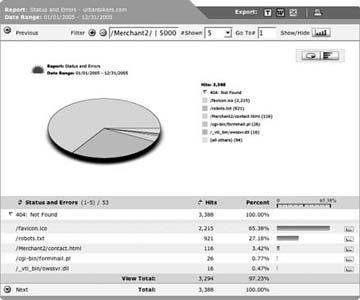Hack72.Know if People Are Bookmarking Your Site
Hack 72. Know if People Are Bookmarking Your Site
One fairly strong indicator of audience loyalty is whether or not people have 'saved your site in their bookmarks folder; use this hack to track this behavior. One of the surest signs of loyalty to a web site is whether visitors are bookmarking your site or saving it in their "favorites" folder for easy access. Because of the addition of a browser feature in Internet Explorer 5.0 and above that attempts to associate an icon with bookmarks, it is relatively easy to get a rough feel for how many people are actively bookmarking your site by monitoring the "favicon." The "favicon" is a 16 x 16-pixel image that, when saved into your document root directory on your web server, is picked up by Internet Explorer and Firefox and presented in bookmark folders and browser toolbars (Figure 5-10). Figure 5-10. A handful of "favicon.ico" imagesTo let web browsers know you have a favicon.ico file, all you need to do is add a little bit of code to your web pages: <link rel="icon" href="/favicon.ico" type="image/x-icon" /> <link rel="shortcut icon" href="/favicon.ico" type="image/x-icon" /> More information about favicon.ico is available at the Microsoft web site (msdn.microsoft.com/workshop/Author/dhtml/howto/ShortcutIcon.asp). 5.6.1. How to Measure Bookmarking with favicon.icoProvided you have a favicon.ico created and deployed in your document root directory, simply ask your web analytics application to tell you how many times the file was requested. You'll need to use a logfile-based measurement tool to make this measurement, but any of the free log analyzer applications [Hack #10] or Stephen Turner's Analog [Hack #11] will suit your purposes just fine. If you haven't created the favicon.ico file, you can also look in your 404 (Page Not Found) [Hack #34] report for presence of this file (Figure 5-11). One important thing to keep in mind is that most applications are going to report requests for favicon.ico on a per-hit [Hack #1] basis. As you'll hopefully recall, "hit" is not a particularly useful term, but in this context, it is worth understanding. The reports are telling you that the file was requested a certain number of times. For example, in Figure 5-11, we can see that the favicon.ico file was requested 2,310 times in the reporting period. This tells you nothing about the number of unique visitors making the request. Because you're unable to determine how many people are actually bookmarking your site based on the number of hits observed, there are two recommendations to improve the usefulness of the data:
5.6.2. Hacking the Hack: Differentiate IE from Firefox RequestsBecause the behavior of Internet Explorer and non-Explorer browsers is slightly different, you may want to use different icon files (or at least different icon filenames) to allow you to differentiate requests. If you use Apache, you can leverage the mod_rewrite module and modify your httpd.conf file, adding the following code: RewriteEngine on RewriteCond %{HTTP_USER_AGENT} !.+MSIE.+ RewriteRule ^/favicon.ico$ /bookmark.ico For this to work, you'll have to have a copy of your favicon.ico file called bookmark.ico in your document root directory. NonInternet Explorer browsers will be directed to the bookmark.ico file, allowing you to get a count for IE and non-IE browsers separately. More information about Apache's mod_rewrite module is available at httpd.apache.org/docs/misc/rewriteguide.html. |
EAN: 2147483647
Pages: 157
